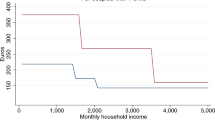Abstract
In spite of relatively generous public subsidies and a reputation for high quality, only a very limited proportion of Italian families use public child-care and a large proportion use informal care. In this paper, we attempt to explore the determinants of the use of child-care among dual workers families. Given the limitations of data available we match two different data sets: the Bank of Italy (SHIW) and ISTAT Multiscopo. We find evidence that the availability of public child-care affects in an important way its demand. We also find that increases in costs of public child-care reduce the use of public as well as private indicating a shift to informal child-care. The presence of a grandmother who lives near and is in good health is an important explanation of the choice especially in presence of very small children. An understanding of the importance of these factors is relevant in the evaluation of child-care policies. This is particularly important in Italy, where the majority of families with children have only one child and children would benefit also from the socialization aspects of the child-care system.
Similar content being viewed by others
References
Addabbo, Tindara and Francesca Olivier. (2002). “Offerta di Lavoro e Servizi all’Infanzia in Italia - L’effetto dell’Introduzione dell’ISE.” Working Paper 381. Centro di Analisi delle Politiche Pubbliche, Modena
Joshua D. Angrist Alan B. Krueger (1992) ArticleTitle“The Effect of Age at School Entry on Educational Attainment: An Application of Instrumental Variables with Moments from Two Samples” Journal of the American Statistical Association 87 328–336
Manuel Arellano Costas Meghir (1992) ArticleTitle“Female Labor Supply and on the Job Search: An Empirical Model Estimated Using Complementary Datasets” Review of Economic Studies 60 631–664
Bank of Italy. (1998). “Survey on Households, Income, and Wealth.” http://www.bancaditalia.it/statistiche/consultazione
Chevalier, Arnaud and Tarja Viitanien. (2004). “The Supply of Childcare in Britain: Do Mothers Queue for Childcare?” Mimeo
Chiuri, Maria Concetta. (2000). “The Quality of Child Care and Female Labour Supply in Italy.” In Daniela Del Boca, and Paola Tanda (eds.), Household Behaviour and Social Policy: Labour, special issue 14, 97–118
Alessandro Cigno Gianna C. Giannelli Furio C. Rosati (1998) ArticleTitle“Voluntary Transfers among Italian Households: Altruistic and Non-Altruistic Explanations” Structural Change and Economic Dynamics 9 435–451 Occurrence Handle10.1016/S0954-349X(98)00044-7
Gordon H. Cleveland Douglas E. Hyatt (1993) ArticleTitle“Determinants of Child Care Choice: A Comparison of Ontario and Quebec” The Canadian Journal of Regional Science 16 53–67
Rachel Connelly (1992) ArticleTitle“The Effect of Child Care Costs on Married Women’s Labor Force Participation” The Review of Economics and Statistics 74 83–90
Dehejia, Rajeev and Sadek Wahba. (1998). “Propensity Score Matching Methods for Non-Experimental Causal Studies.” Working Paper 6829, National Bureau of Economic Research (NBER)
Rajeev Dehejia Sadek Wahba (1999) ArticleTitle“Causal Effects in Non-Experimental Studies: Reevaluating the Evaluation of Training Programs” Journal of American Statistical Association 94 1053–1062
De Henau, Jerome, Daniele Meulders, and Sile O’Dorchai. (2006). “The Child Care Triad? Indicators Assessing Three Fields of Child Policies towards Dual Earner Families in the EU-15.” Journal of Comparative Policy Analysis, special issue (forthcoming January 2006)
Daniela Del Boca (2002) ArticleTitle“The Effects of Child Care and Part Time on the Participation and Fertility Decisions in Italy” Journal of Population Economics 15 549–573 Occurrence Handle10.1007/s001480100089
Fondazione degli Innocenti. (2002). “I servizi Educativi per la Prima Infanzia.” Quaderno 21
Siv Gustafsson Frank P. Stafford (1992) ArticleTitle“Child Care Subsidies and Labor Supply in Sweden” The Journal of Human Resources 27 204–229
Sandra L. Hofferth Douglas A. Wissoker (1992) ArticleTitle“Price, Quality, and Income in Child Care Choice” The Journal of Human Resources 27 70–111
ISTAT. (1999, 2000, 2001). “Annuario Statistico Italiano.” Years 1999, 2000 and 2001
ISTAT. (1998a). “Statistiche della Scuola Materna ed Elementare,” anno scolastico 1995–96, Annuari Ed. 1998
ISTAT. (1998b). “Forze di Lavoro”
ISTAT. (1998c). “Indagine Multiscopo”
Jutta M. Joesch Bridget G. Hiedemann (2002) ArticleTitle“The Demand for Non Relative Child Care among Families with Infants and Toddlers: A Double-Hurdle Approach” Journal of Population Economics 15 495–526 Occurrence Handle10.1007/s001480100112
Michaela Kreyenfeld Hank. Karsten (2000) ArticleTitle“Does the Availability of Child Care Influence the Employment of Mothers? Findings from Western Germany” Population Research Policy Review 19 317–333
Karen Kuhlthau Karen O. Mason (1996) ArticleTitle“Market Child Care versus Care by Relatives” Journal of Family Issues 17 561–578
Charles Michalopoulos Philip K. Robins (2002) ArticleTitle“Employment and Child Care Choices of Single-Parent Families in Canada and the United States” Population Economics 15 465–493
Ministero del Lavoro e delle Politiche Sociali. (2002). “I Servizi Educativi per la Prima Infanzia”
Brett R. Moulton (1990) ArticleTitle“An Illustration of a Pitfall in Estimating the Effects of Aggregate Variables on Micro Units” The Review of Economics and Statistics 72 334–338
OECD. (1999, 2000, 2001). “Employment Outlook”
David C. Ribar (1992) ArticleTitle“Child Care and the Labour Supply of MarriedWomen: Reduced Form Evidence” The Journal of Human Resources 27 135–165
David C. Ribar (1995) ArticleTitle“A Structural Model of Child Care and the Labor Supply of Married Women” The Journal of Labor Economics 13 558–597 Occurrence Handle10.1086/298385
Paul R. Rosenbaum Donald B. Rubin (1983) ArticleTitle“The Central Role of the Propensity Score in Observational Studies for Causal Effects” Biometrika 70 41–55
Donald B. Rubin (1977) ArticleTitle“Assignment to a Treatment Group on the Basis of a Covariate” Journal of Educational Statistics 2 1–26
Wrohlich, Katharina. (2005). “The Excess Demand for Subsidized child-care in Germany.” Working Paper 1515, Institute for the Study of Labor (IZA)
Author information
Authors and Affiliations
Corresponding author
Additional information
We would like to thank Christopher Flinn, Massimiliano Bratti, and Maria Concetta Chiuri for helpful comments, Donald Rubin for useful hints on the matching procedure, and participants at the ESPE meeting in New York 2003, the EALE meeting in Lisbon 2004. This research was partially supported by the EC Grant and the Compagnia di San Paolo.
Rights and permissions
About this article
Cite this article
Del Boca, D., Locatelli, M. & Vuri, D. Child-Care Choices by Working Mothers: The Case of Italy. Rev Econ Household 3, 453–477 (2005). https://doi.org/10.1007/s11150-005-4944-y
Received:
Accepted:
Issue Date:
DOI: https://doi.org/10.1007/s11150-005-4944-y




